Support
Support
Synargy was built on the desire to create furniture that fits your life, and that’s our promise.
A clear vision, supported by a dynamic team, brings you furniture with enduring quality, design, comfort and style. Our uncompromising commitment and personality for customer care ensures that our products and services are the best available.
For decades Synargy has developed high quality furniture, built to the needs of its customers. Our aim is to raise standards through innovation, quality materials and ensuring consistency throughout the manufacturing process. Our design team is highly experienced at combining world class design with carefully chosen materials and components that are tested to the highest standards.
We deliver comfort, strength and durability that you can depend on.
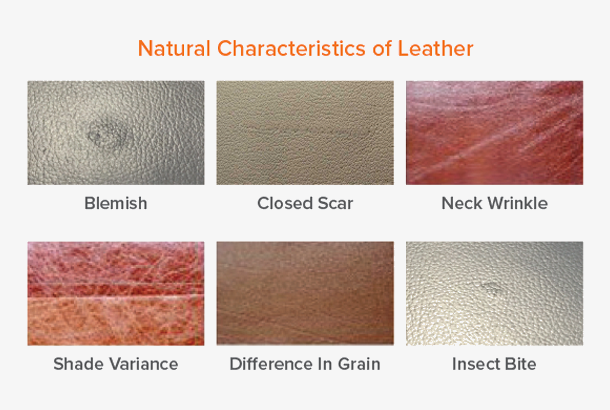
Our premium leather range has a luxury look and soft touch that sets our lounge suites apart from others. We specify a select grade of top grain corrected cow hide which makes it soft to the touch, durable and easy to maintain.
As a natural product, our leather shows the hallmarks of its previous life. Wrinkles, scars and slight imperfections should all be treated as signs of the leather’s authenticity. No two hides are alike and nature’s signatures on each piece ensure your Synargy range furniture is unique.
Corrected Top Grain
The Synargy range uses corrected top grain leather as it offers the best of both worlds – softness and high durability. Top grain is the strong top layer from a hide when it is split. To ensure a more uniform finish, any excessive imperfections such as scars, insect bites and marks are corrected. This is done by lightly sanding the surface. A new grain pattern is then embossed in the leather to provide an overall even finish. A protective pigment is added making it ideal for the demands of everyday life.
Caring For Your Leather
Remember that leather is an animal hide, so you need to look after it like you would your own skin - clean and moisturise to ensure it stays soft and hydrated. Under normal usage conditions, regular dusting and vacuum cleaning in crevices or bottoms is all that is necessary to clean your furniture. The use of a good leather conditioner is recommended every 4-6 months. Protect your furniture from the sun – especially direct light. Leather can fade to some degree if exposed to the sun. For minor or slight scratches on the surface, use a chamois or clean finger to gently buff the scratch. If needed, moisturise lightly with distilled water to work scratches out.
A brief background on what makes Synargy leather so high quality and desirable
Tips and recommendations for maintenance & cleaning spots and spills, to keep your leather looking its best for longer.
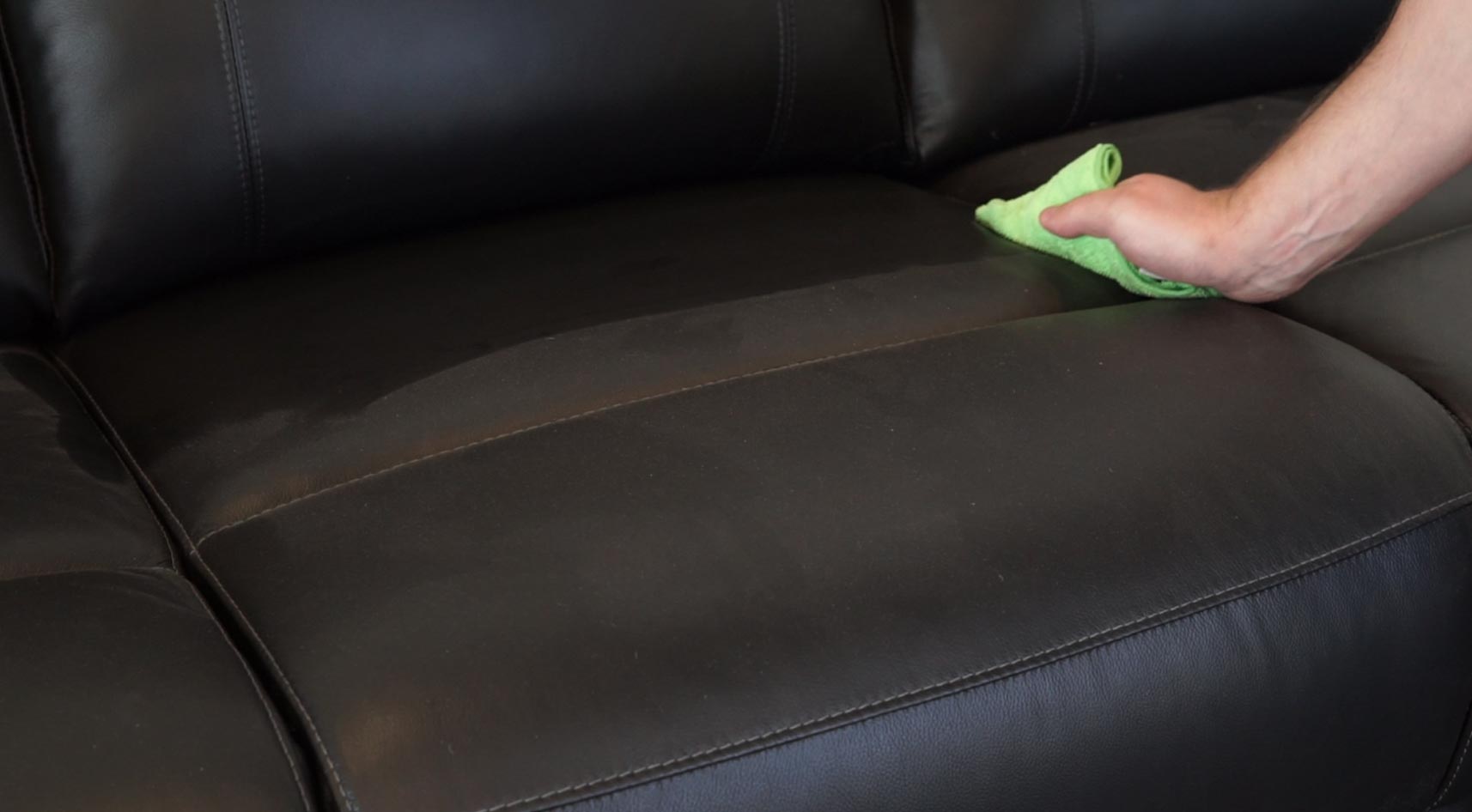
For Spots and Spills
Blot excess liquid immediately with a clean, absorbent cloth or sponge. If necessary, use clean, lukewarm water and gently wipe the spill. Dry with a clean towel and allow to air dry. If water is used, clean the entire area where the spill occurred. For example, the entire seat cushion or entire arm. Do not dry wet areas with hair dryers, etc.
For Stubborn Spots and Spills
Use a mild solution of ivory soap and clean, lukewarm water. Apply the soap to a clean wet sponge and wash, then rinse well. Let air dry naturally. Always try the cleaning method in a hidden area first to convince yourself of the results. If the stain persists, it is recommended that the leather be cleaned by a professional leather specialist to avoid any potential damage to the leather.
For Butter, Oil or Grease
Wipe excess butter, oil or grease off the leather with a clean, dry cloth, then leave it alone as the spot should dissipate into the leather in a short period of time. Do not apply water to try to wash butter, oil or grease spot.
Do Not Use
Furniture polish, saddle soaps, oils, abrasive cleaners, soaps or varnish. The leather has been permanently preserved in the tanning process and needs no maintenance other than the simple cleaning recommended.
Note
Most liquids will be initially repelled by the leather, but, if left to stand over an extended period of time, they will be absorbed. That is why it is a good idea to mop up spills immediately. But even if the spill is absorbed, it will dissipate in time, just as human skin will absorb and eventually diffuse stains. Wipe surfaces weekly with a soft damp cloth to prevent the buildup of dust, body oils and dirt on the leather surface.
Maintain at least 2m distance between your furniture and heat sources.
Medications: If leather furniture is used constantly by individuals on some medications, (including, but not limited to; chemotherapy, blood pressure and heart medications), extra care should be taken to protect leather surfaces from direct skin contact as the chemistry in these medications may react with and damage the leather finish. Headrest covers and arm protectors are advisable.
Be aware of sharp edges on clothing and accessories as these can cause damage to your furniture.
Keep pets off furniture. Claws can cause scratches and body oils from skin and fur can result in premature deterioration of the surface.
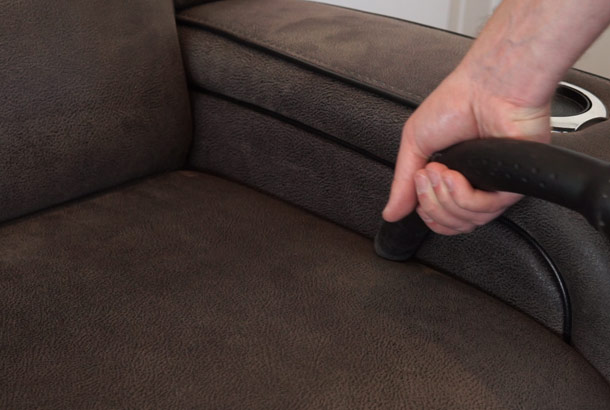
Our quality fabric selection is tested for wearability, seam strength and colour fastness to light to ensure it will stand up to the rigours of everyday family use.
Caring For Your Fabric
Vacuum clean regularly using low suction and a soft brush accessory.
Clean spills and stains as soon as possible. Gently scrape any excess material off and mop liquid from the surface of the fabric. Do not scrub the area as this will create a noticeable difference in the texture of the fabric. Gently dab the spill taking care not to saturate the fabric or filling with water or cleaning fluid.
Apply fabric cleaners strictly according to the instructions. Always test cleaners on an inconspicuous area before using. Refer to the fabric cleaning code on your furniture for more details on the fibre content.
Fabric pilling can occasionally occur as a result of normal daily wear and should not be considered a fault. Pilling can be removed with a pilling tool, available from most homeware stores.
Maintain at least 2m distance between your furniture and heat sources.
Avoid placing your furniture in direct sunlight. All materials will fade over time from sustained exposure to direct sunlight.
Be aware of sharp edges on clothing and accessories as these can damage your furniture.
Keep pets off furniture. Claws can cause scratches and body oils from skin and fur can result in premature deterioration of the surface.
Tips and recommendations for maintenance & cleaning spots and spills, to keep your fabric suite clean and tidy.
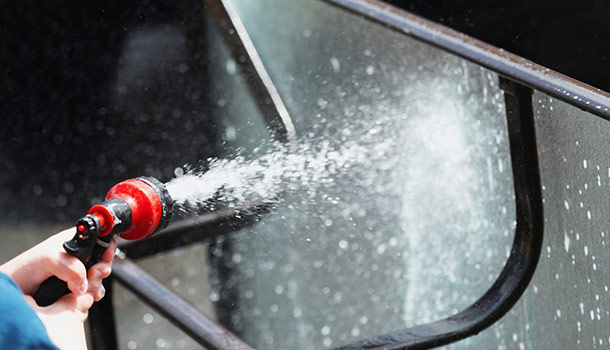
Care & Maintenance Basics
Protect outdoor furniture from constant direct sunlight and heat to prevent fading and drying out.
Store your furniture and cushions in a dry covered area when not in use.
Do not use a water blaster to clean your furniture as it can damage surfaces. Loose dust or dirt can be removed with a hose on a medium flow setting.
Never use harsh chemicals or paint around your furniture.
Always start with a light cleaning, sweeping surfaces as needed with a soft brush or cloth. Then assess if further care and cleaning is needed.
When it comes to cleaning products for outdoor furniture, mild detergent is your friend. It will clean but not harm your furniture.
For tougher stains and mildew, use water and white vinegar.
Salt water, chlorine, sunscreens, and bird droppings should be cleaned off your furniture as soon as possible. They can be particularly damaging and cause permanent stains and corrosion.
Allow furniture to dry completely before use or covering.
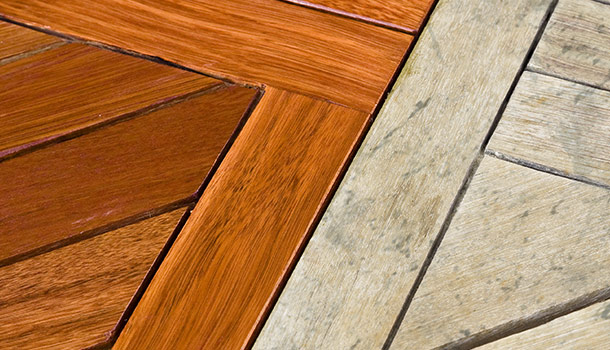
Timber is a natural product which can expand and contract under different weather conditions. This may lead to micro fractures in the timber which is perfectly natural.
Regular cleaning:
We recommend you tighten the screws in timber furniture regularly.
Clean dust or dirt with a damp cloth, or soft brush, and mild detergent, like dishwash. Use cleaning products without silicone or ammonia products. These products contain properties that can create dryness in the timber that can eventually lead to cracking.
Hose off any loose dirt or dust on a medium setting. Do not use a water blaster.
Dry thoroughly.
Long-term maintenance needs of outdoor timber furniture primarily depend on the look you are after. Left untreated most timbers develop a natural silver weathered patina. This is not considered a warranty issue and does not affect the structural strength of the frame.
If you want to keep your timber looking closer to its original finish, this will require yearly maintenance. To restore the finish to its original state, lightly sand and apply a coat of timber oil, stain, or varnish.
You can make a simple polish by mixing 1 cup of olive oil with 1/4 cup white vinegar or purchase a timber oil from a hardware store. Pour it on a soft cloth and work it into the timber, wiping with the grain. Buff until shiny.
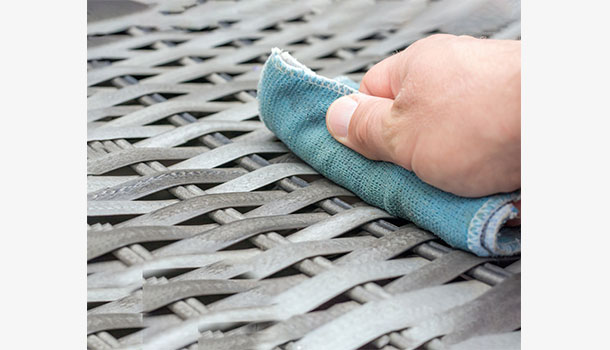
Our outdoor wicker furniture combines the classic look of wicker with the highest quality man-made materials for durability.
Hose off any loose dirt or dust on a medium setting. Do not use a water blaster. Use a soft bristle brush and a mild detergent to clean the wicker.
An old toothbrush may be used for areas the soft brush can’t reach. Thoroughly rinse off all cleaning residue with a hose on a medium setting and allow to dry naturally outdoors.
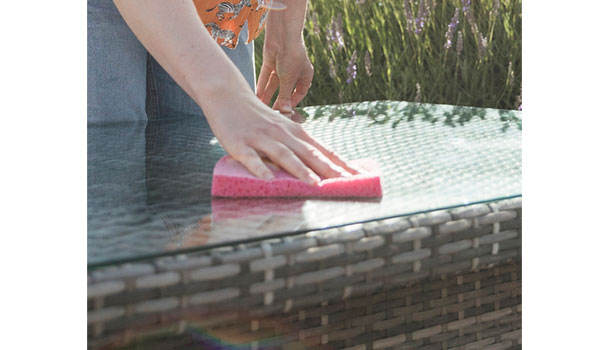
Wipe down with a soft dry cloth to remove any loose dirt or dust. Use a glass cleaner and a soft damp cloth to remove any remaining dirt or marks.
Avoid using abrasive cleaners or coarse cleaning pads as these may scratch the surface. Both sides of glass tops may need to be cleaned to achieve a desirable finish.
Carefully remove the top from your furniture to clean the underside.
Avoid placing hot/cold items directly on the glass surface.
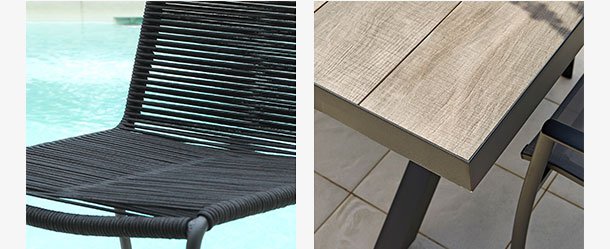
Remove any loose dust or dirt with a damp soft cloth.
A mild detergent and soft bristled brush can be used to remove more stubborn marks.
Thoroughly rinse off cleaning residue with a hose on a medium setting. Do not use abrasive cleaners or solvents to clean.
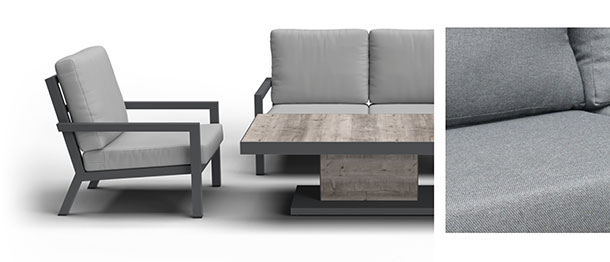
To clean, wipe gently with a damp soft cloth and mild detergent. Maximum water temperature is 30 degrees. Use a soft bristle brush to lift any ingrained dirt or stains. Wipe clean with a damp soft cloth when finished cleaning.
Treat spills as soon as they occur. Do not dry clean, machine wash, tumble dry or bleach.
Although these fabrics have been treated to resist stains, it may become necessary over time to use commercially available cleaners; always follow the manufacturer's instructions.
Information on cleaning specific spills and stains from fabric can be found in our outdoor care & warranty booklet, available here.
Care & Maintenance Basics
Whether you use your furniture daily, or only for special occasions, regular care will protect your investment and ensure you can enjoy it for years to come.
To extend the life of your furniture, avoid direct sunlight. All materials will fade over time if placed in direct sunlight. This may cause colour fade variations and is not considered a fault.
Direct heat contact from cooking dishes, tea pots and coffee mugs etc should be avoided. Hot items placed on surfaces can cause surface blemishes. Frozen items can cause a similar effect.
Pressure from sharp objects such as knives and ball point pens can cause unwanted marks. Always place something over the surface before using.
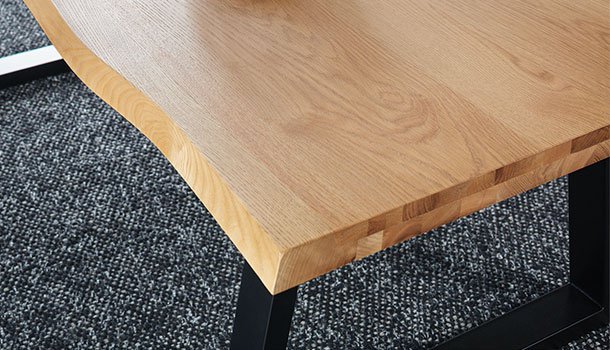
Wipe your furniture regularly with a damp cloth, then dry with a clean, lint-free cloth.
Wipe up any spills immediately - if it leaves a stain, mix 1-part white vinegar in 2-parts soapy water and dab with a clean microfibre cloth. Dab in the direction of the grain and dry the surface.
Use a diluted, timber-friendly detergent on any stubborn marks.
Do not use harsh or abrasive chemicals, polishes, or sprays - this includes fingernail polish and remover, bleach, glue, and household cleaners.
To repair small scratches on veneer, you can use a small amount of oil polish, and for solid wood, you can seal with matching varnish or paint. Always test a discrete area before you do this.
Coasters and placemats protect the furniture’s surface from moisture and heat – do not place hot drinks or plates directly on your furniture.
Try to keep your furniture out of direct sunlight – this can cause colour fading and movement of the timber.
Do not put your furniture directly in front of a heat source – on veneered furniture, this can cause the veneer to lift away, and cause solid timber to move.
Solid timber is a changeable and natural material, so excess heat, cold and moisture will affect the timber and over time could cause bowing or hairline cracks.
Wipe your furniture regularly with a damp cloth, then dry with a clean, lint-free cloth.
Use a diluted, mild detergent on any stubborn marks.
Do not use harsh or abrasive chemicals, polishes, or sprays - this includes fingernail polish and remover, bleach, glue, and household cleaners.
Wipe up any spills immediately.
Lacquer can be scratched, so make sure everyone uses a placemat and be careful that jewellery does not scratch the surface.
Wipe away finger marks with a soft microfibre cloth.
To remove felt tip or biro pen marks, spray hairspray on the aff ected area and leave for a moment before wiping away. Test on an inconspicuous area first!
Wipe away spills and finger marks with a clean, dry cloth.
Polish with glass cleaner.
Glass can scratch - Every day scratches are usually only visible in certain light and at certain angles. Be cautious with jewellery and sliding plates and use placemats as a protective layer.
Wipe your furniture regularly with a damp cloth, then dry with a clean, lint-free cloth.
Use a diluted, mild detergent on any stubborn marks.
Add a splash of white vinegar for an extra boost.
Using a diluted, mild detergent, wipe your furniture regularly with a damp cloth, then dry with a clean, lint-free cloth.
For harder to remove marks, use window cleaner or 50:50 water and white vinegar spray.
Vacuum clean regularly using low suction and a soft brush accessory.
Clean spills and stains as soon as possible. Gently scrape any excess material off and mop liquid from the surface of the fabric.
Do not scrub the area as this will create a noticeable difference in the texture of the fabric.
Gently dab the spill taking care not to saturate the fabric or filling with water or cleaning fluid.
Apply fabric cleaners strictly according to the instructions. Always test cleaners on an inconspicuous area before using.
Avoid placing your furniture in direct sunlight. All materials will fade over time from sustained exposure to direct sunlight.
Be aware of sharp edges on clothing and accessories as these can damage your furniture.
Keep pets off furniture. Claws can cause scratches and body oils from skin and fur can result in premature deterioration of the surface.